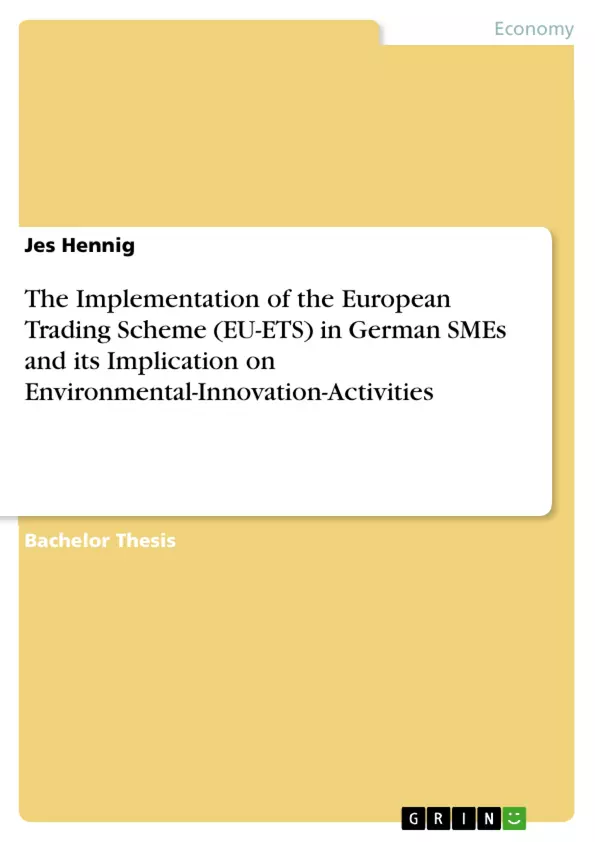The implementation of the European Trading Scheme (EU-ETS) regulatory in 2005 is the consequence of the rising emission of greenhouse-gases (GHG). Currently, Europe emits
about 3.74 billion tonnes pollution per year, which is high but – looking from a global angle nevertheless below the US’ and China’s level of emissions. The reason for the increased pollution is the growth of demand and consequently productivity that has compound over time but needs to be stopped. The EU-ETS is Europe’s instrument to achieve the Global Temperature Target, whose goal is to decrease the overall temperature by two-degrees Celsius and thereby to reduce the negative externalities for the society and in the long run for the world. Furthermore the aim of the EU-ETS is to stop the growth of emissions of greenhouse gases and to declare binding targets for 2020 in order to reduce emissions by 20 per cent compared to the level of 2005 . The implementation of the regulatory has marked a turning point in the European policy because it was the first time that a marketbased approach of tradable permits got implemented in a cross-national way. It is the biggest implementation of a cap-and-trade scheme and the engine of the European climate policy. The German industrial landscape is shaped by small and medium-sized Enterprises (SMEs) 1 that account for approximately 99.7 per cent of all enterprises in Germany. Hence, around half of the German companies who need to participate in the EU-ETS are SMEs. The European Commission stated in their Enterprise and Industry Fact Sheet released in 2013 that “German SMEs continue to be more innovative and internationally orientated than most of their EU partners”. As SMEs are important for German economy and are innovative orientated it is especially important to investigate how they are implementing the above-described EU-ETS. With the help of the linkage between these two key aspects – the innovative SMEs in the German economy and the implementation of the EU-ETS – this thesis investigates how German SMEs implement the EU-ETS in their value chain and in how far they – as a consequence of the EU-ETS regulatory – are developing innovations regarding pollution reducing measures.
Inhaltsverzeichnis (Table of Contents)
- Introduction
- Methodology
- EU-ETS
- Theoretical background: Implementation and development of the EU-ETS
- Phase I
- Phase II
- Phase III
- Political asymmetry and carbon leakage
- Theoretical background: Implementation and development of the EU-ETS
- Status quo of the EU-ETS
- SMEs in the German economy
- Adaption of the EU-ETS within German SMEs
- Environmental-innovation-activities
- Short-term impacts of eco-innovation-activities
- Long-term impacts of eco-innovation-activities
- Porter hypothesis
- Porter hypothesis within the EU-ETS
- Criticism on Porters' hypothesis
- Further research
Zielsetzung und Themenschwerpunkte (Objectives and Key Themes)
This thesis examines the implementation of the European Trading Scheme (EU-ETS) within German small and medium-sized enterprises (SMEs) and investigates the resulting impacts on environmental innovation activities. The study aims to understand how SMEs adapt to the regulatory requirements of the EU-ETS and explore the potential for innovation in pollution-reducing measures.
- The implementation of the EU-ETS within German SMEs
- The impact of the EU-ETS on environmental innovation activities in SMEs
- The role of the Porter hypothesis in the context of the EU-ETS
- The importance of SMEs for the German economy
- The potential for synergy between environmental protection and innovation
Zusammenfassung der Kapitel (Chapter Summaries)
The introduction provides an overview of the EU-ETS and its significance for reducing greenhouse gas emissions. It also highlights the importance of SMEs in the German economy and the need to understand their role in implementing the EU-ETS.
The methodology chapter outlines the research approach used in the study. It explains the data sources, research methods, and analytical framework employed.
The EU-ETS chapter delves into the theoretical background of the scheme, covering its implementation and development across different phases. It also discusses the challenges of political asymmetry and carbon leakage.
The status quo of the EU-ETS chapter analyzes the current state of the scheme, examining its effectiveness and limitations.
The SMEs in the German economy chapter explores the characteristics and role of SMEs in the German economy. It then focuses on how SMEs are adapting to the EU-ETS and the implications for their environmental innovation activities.
The Porter hypothesis chapter examines the potential for the EU-ETS to stimulate innovation and economic growth, exploring both the theoretical framework and criticisms of the hypothesis.
The further research chapter outlines potential areas for future research in this field.
Schlüsselwörter (Keywords)
The key terms and concepts explored in this thesis include the European Trading Scheme (EU-ETS), small and medium-sized enterprises (SMEs), environmental innovation, pollution reduction, greenhouse gas emissions, the Porter hypothesis, and the German economy.
- Quote paper
- Jes Hennig (Author), 2014, The Implementation of the European Trading Scheme (EU-ETS) in German SMEs and its Implication on Environmental-Innovation-Activities, Munich, GRIN Verlag, https://www.grin.com/document/295506



